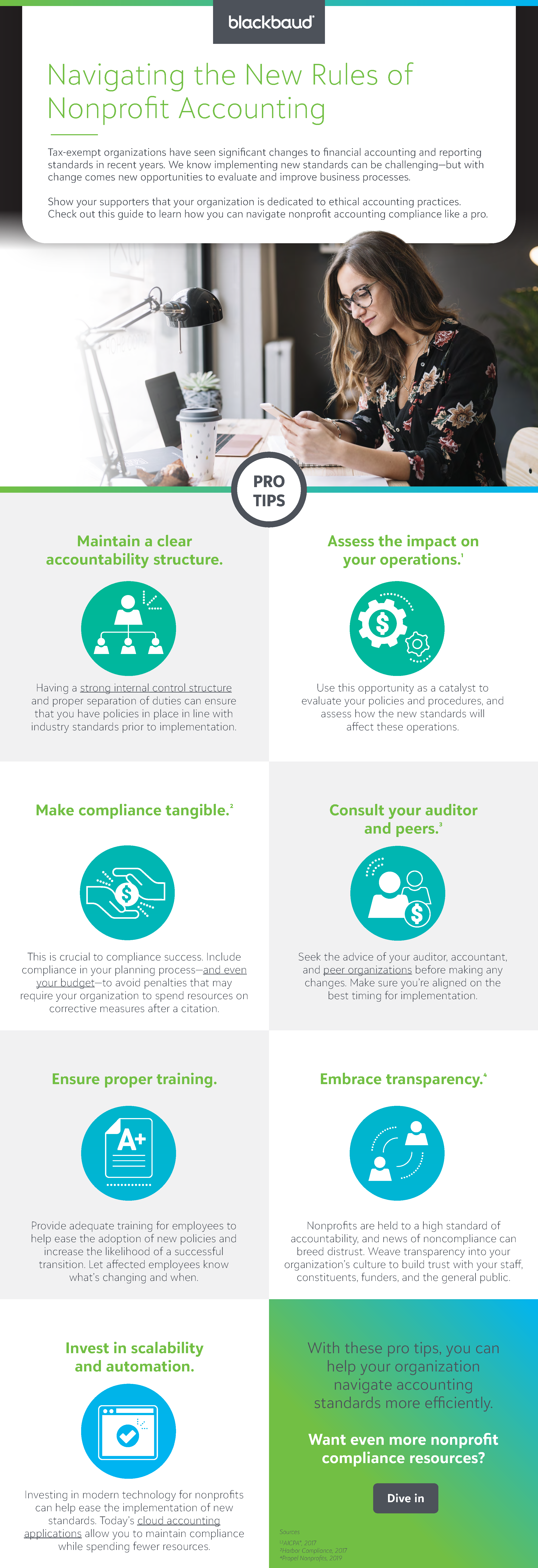Tax-exempt organizations have seen significant changes to financial accounting and reporting standards in recent years. Implementing new standards can be challenging, but the cost of noncompliance can be devastating: a tarnished reputation, loss of funding, or even revocation of exempt status.
But with change comes new opportunities to evaluate and improve on existing business processes and demonstrate to existing and potential supporters that your organization is dedicated to compliance and ethical accounting practices. This article and infographic provides tips for getting started with compliance change management.
1. Maintain a clear accountability structure.
Having a well-documented internal control structure and proper separation of duties can ensure that you have sound policies in place prior to starting implementation.
“Your primary focus should be making sure that your organization has a clear accountability structure for compliance, rather than a “let’s make a deal” culture in which issues are addressed only after they have become bigger problems.”—Lucy Morgan, Founder and Director, MyFedTrainer.com, How to Build Trust with Strong Internal Controls
2. Assess the impact on your operations.
86% of nonprofits expected demand for services to increase in 2018 while 58% said that federal funding policies have become more challenging. (Source: 2018 State of the Nonprofit Sector Survey, Nonprofit Finance Fund)
Compliance change management can be time-consuming and onerous. Coupled with the growing need for nonprofit services, it’s more important than ever for organizations to make the most efficient use of their resources.
As you prepare to implement new standards, evaluate your existing policies, processes, and technology to assess whether or not you have the capacity to meet regulatory requirements without diverting resources away from mission delivery. How much will your current business processes be impacted? Do you have the expertise in-house to implement the changes, or will your organization need to hire a contractor to guide the process? What are the potential challenges or risks we might face during and after the transition?
3. Make compliance tangible.
This is crucial to compliance success. Include compliance in your planning process—and even your budget—to avoid penalties that may require your organization to spend resources on corrective measures after a citation.
“Regulatory requirements should be a line item in every budget. If you don’t have one at all, you need one. Even if it starts small, organizations should have this line item to make the concept of compliance tangible.”—Brock Klinger, Nonprofit Account Executive, Harbor Compliance
4. Consult your auditor and peers.
Seek the advice of your auditor, accountant, and peer organizations to:
- Make sure you understand what the new standards mean and how they should be applied at your organization
- Determine the best time for implementation to lessen the disruption to your operations
- Learn how similar organizations have approached implementation and what challenges they’ve faced along the way
“The biggest tip is not to reinvent the wheel. Rather than start from scratch in determining how to put together a policy or determine how to prepare for a new law, it’s a much more effective use of time to reach out to peers and see how they are handling things.”—Kitty Holt, Not-for-Profit Compliance: Doing More with Less, The Wall Street Journal
Learn more about accounting standards in the free eBook “The New Rules for Nonprofit Accounting and Reporting”
5. Ensure proper training.
Providing adequate training for employees is vitally important for any change management process. It helps ease the adoption of new policies and increase the likelihood of a successful transition. Employees impacted by new standards should receive proper communication and training on what’s changing, when it’s happening, and how they’ll be involved.
“17% of nonprofit staff at the most effective nonprofits reported zero [dollars] spent on training. That rose to 26% at the least effective nonprofits.”—2018 Nonprofit Communications Trend Report, http://bit.ly/1fESfaS
6. Embrace transparency.
Nonprofits are held to a high standard of accountability, and news of noncompliance can breed distrust. Making transparency part of your organization’s culture will help build trust with your staff, constituents, funders, and the general public.
“Leaders of charitable nonprofits know that financial transparency will help preserve the very-important trust each donor places in a nonprofit with each contribution. Additionally, and no less importantly, conduct that is accountable and transparent earns employees’ trust and creates a positive workplace culture.”—Financial Transparency, Council of Nonprofits
7. Invest in scalability and automation.
Today’s cloud accounting applications have come a long way from their on-premises predecessors in delivering efficiency, accessibility, and scalability. Modern advancements—from automated reporting tools to automatic software updates that ensure your system is always current and up to date with the latest innovations—can help your organization streamline compliance efforts.
“When selecting accounting information technology, it is important for nonprofits not only to consider the current capabilities of proposed solutions, but also the likelihood of individual solutions to support future compliance requirements.”—Adam Bluemner, Blackbaud, Compliance Risk Management for the Empowered Nonprofit
from npENGAGE http://bit.ly/2LPBWkO

Hey there, Join & Donate! I stumbled upon your blog post about 7 tips for navigating nonprofit organizations, and I wanted to drop a comment to share my thoughts. Navigating the nonprofit sector can be an enriching and rewarding experience, and your tips provide valuable guidance for individuals looking to get involved or support these organizations.
ReplyDeleteLearn more about:
iva intelligent virtual agents
appointment management
conversational intelligence platform
digital communication for financial services
digital communication for call center
reputation mangement
video digital banking
digital communication for payment systems
text messaging communication channel